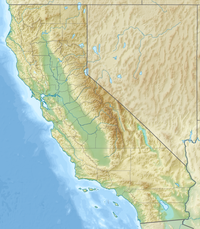Merced Peak
| Merced Peak | |
|---|---|
 South aspect, aerial view | |
| Highest point | |
| Elevation | 11,731 ft (3,576 m) NAVD 88[1] |
| Prominence | 1,206 ft (368 m)[1] |
| Listing | Sierra Peaks Section[2] |
| Coordinates | 37°38′07″N 119°23′41″W / 37.6352111°N 119.3945904°W[3] |
| Geography | |
| Location | Madera County, California, U.S. |
| Parent range | Clark Range |
| Topo map | USGS Merced Peak |
| Climbing | |
| Easiest route | Scramble, class 2[2][4] |
Merced Peak, with an elevation of 11,731 feet (3,576 m), is the highest point in the Clark Range,[1] just surpassing three other peaks; Red Peak (11,704 feet),[5] Gray Peak (11,578 feet),[6] and Mount Clark (11,527 feet).
Merced Peak is located close to southern border of Yosemite National Park, near the Ottoway Lakes. The summit can be approached from the Quartz Mountain Trailhead over Chiquito pass or from one of two trailheads on the road to Glacier Point.[7]
In 1871, influential Scottish-American naturalist John Muir discovered an active alpine glacier below Merced Peak, which helped his theory that Yosemite Valley was formed by glacial action gain acceptance.
Climate
[edit]According to the Köppen climate classification system, Merced Peak is located in an alpine climate zone.[8] Most weather fronts originate in the Pacific Ocean, and travel east toward the Sierra Nevada mountains. As fronts approach, they are forced upward by the peaks (orographic lift), causing moisture in the form of rain or snowfall to drop onto the range.
| Climate data for Merced Peak (CA) 37.6362 N, 119.3897 W, Elevation: 11,165 ft (3,403 m) (1991–2020 normals) | |||||||||||||
|---|---|---|---|---|---|---|---|---|---|---|---|---|---|
| Month | Jan | Feb | Mar | Apr | May | Jun | Jul | Aug | Sep | Oct | Nov | Dec | Year |
| Mean daily maximum °F (°C) | 32.7 (0.4) |
31.9 (−0.1) |
34.8 (1.6) |
37.9 (3.3) |
45.1 (7.3) |
54.8 (12.7) |
62.9 (17.2) |
62.0 (16.7) |
56.6 (13.7) |
47.7 (8.7) |
38.7 (3.7) |
32.7 (0.4) |
44.8 (7.1) |
| Daily mean °F (°C) | 23.9 (−4.5) |
22.1 (−5.5) |
24.5 (−4.2) |
27.3 (−2.6) |
34.0 (1.1) |
43.5 (6.4) |
51.1 (10.6) |
50.4 (10.2) |
45.0 (7.2) |
37.0 (2.8) |
28.9 (−1.7) |
23.5 (−4.7) |
34.3 (1.3) |
| Mean daily minimum °F (°C) | 15.2 (−9.3) |
12.3 (−10.9) |
14.2 (−9.9) |
16.6 (−8.6) |
23.0 (−5.0) |
32.3 (0.2) |
39.2 (4.0) |
38.8 (3.8) |
33.4 (0.8) |
26.4 (−3.1) |
19.2 (−7.1) |
14.2 (−9.9) |
23.7 (−4.6) |
| Average precipitation inches (mm) | 12.16 (309) |
10.66 (271) |
9.43 (240) |
5.30 (135) |
3.36 (85) |
0.89 (23) |
0.61 (15) |
0.52 (13) |
0.79 (20) |
3.31 (84) |
5.25 (133) |
10.75 (273) |
63.03 (1,601) |
| Source: PRISM Climate Group[9] | |||||||||||||
See also
[edit]Gallery
[edit]References
[edit]- ^ a b c "Merced Peak". Peakbagger.com. Retrieved June 17, 2011.
- ^ a b "Sierra Peaks Section List" (PDF). Angeles Chapter, Sierra Club. Retrieved February 23, 2014.
- ^ "Merced Peak". Geographic Names Information System. United States Geological Survey, United States Department of the Interior. Retrieved June 17, 2011.
- ^ Secor, R.J. (2009). The High Sierra Peaks, Passes, and Trails (3rd ed.). Seattle: The Mountaineers. pp. 408–409. ISBN 978-0898869712.
- ^ "Red Peak, California". Peakbagger.com. Retrieved February 23, 2014.
- ^ "Gray Peak, California". Peakbagger.com. Retrieved March 8, 2012.
- ^ "Merced Peak". SummitPost.org. Retrieved March 8, 2012.
- ^ "Climate of the Sierra Nevada". Encyclopædia Britannica.
- ^ "PRISM Climate Group, Oregon State University". PRISM Climate Group, Oregon State University. Retrieved October 8, 2023.
To find the table data on the PRISM website, start by clicking Coordinates (under Location); copy Latitude and Longitude figures from top of table; click Zoom to location; click Precipitation, Minimum temp, Mean temp, Maximum temp; click 30-year normals, 1991-2020; click 800m; click Retrieve Time Series button.
External links
[edit]- "Merced Peak". SummitPost.org.
- "Merced Peak". Climber.org.




